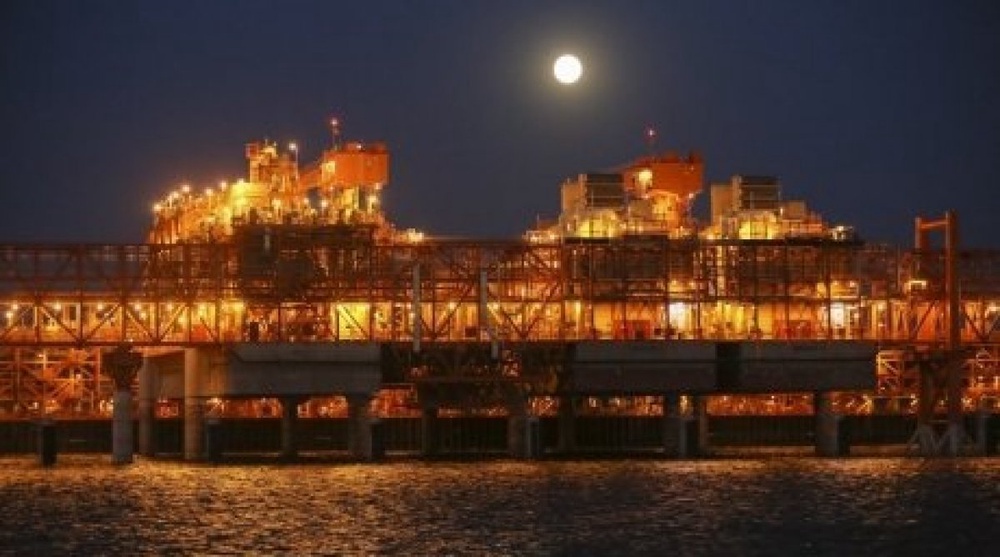
The recent 20% currency devaluation has nothing to do with suspension of production at the giant Kashagan oilfield, Tengrinews.kz reports, citing the country’s Oil and Gas Minister Uzakbai Karabalin as saying. “Kashagan couldn’t have any influence on revenues that the Government had been planning to gain from crude sales in 2014”, he said at the President’s Public Communications Service when commenting on widely spread speculations that the currency devaluation was reportedly needed to offset the lost revenues from Kashagan. He reminded that in line with PSAs, in the first years of production the revenues are primarily harvested by developing companies so that they could recoup their investments. In this context, the share of Kazakhstan’s revenues in 2014 wouldn’t be sufficiently sizeable to have an impact on the national currency. Commercial production at Kashagan started September 11, 2013. However, it was suspended 2 weeks later due to a gas leakage. The production process was resumed shortly. However, another leakage was detected in October. The Kashagan field, named after a 19th century Kazakh poet from Mangistau, is located in the Kazakhstan sector of the Caspian Sea and extends over a surface area of approximately 75 kilometers by 45 kilometers. The reservoir lies some 4,200 meters below the shallow waters of the northern part of the Caspian Sea and is highly pressured (770 bar of initial pressure). The crude oil that it contains has high ‘sour gas’ content. The development of Kashagan, in the harsh offshore environment of the northern part of the Caspian Sea, represents a unique combination of technical and supply chain complexity. The combined safety, engineering, logistical and environmental challenges make it one of the largest and most complex industrial projects currently being developed anywhere in the world. According to Kazakhstan geologists, geological reserves of Kashagan are estimated at 4.8 billion tons of oil. According to the project’s operator, the oilfield’s reserves are estimated at 38 billion barrels, with 10 billion barrels being recoverable. Besides, natural gas reserves are estimated at over 1 trillion cubic meters. “We expect Kashagan to come on stream shortly. The volume of crude to be produced hinges on the period of repairs currently under way. Our estimates stand at about 2 million tons for 2014”, Tengrinews.kz reported mid-January 2014, quoting the country’s Oil and Gas Minister Uzakbai Karabalin as saying at a press-conference following the sitting of KAZENERGY petroleum association.





The recent 20% currency devaluation has nothing to do with suspension of production at the giant Kashagan oilfield, Tengrinews.kz reports, citing the country’s Oil and Gas Minister Uzakbai Karabalin as saying.
“Kashagan couldn’t have any influence on revenues that the Government had been planning to gain from crude sales in 2014”, he said at the President’s Public Communications Service when commenting on widely spread speculations that the currency devaluation was reportedly needed to offset the lost revenues from Kashagan.
He reminded that in line with PSAs, in the first years of production the revenues are primarily harvested by developing companies so that they could recoup their investments. In this context, the share of Kazakhstan’s revenues in 2014 wouldn’t be sufficiently sizeable to have an impact on the national currency.
Commercial production at Kashagan started September 11, 2013. However, it was suspended 2 weeks later due to a gas leakage. The production process was resumed shortly. However, another leakage was detected in October.
The Kashagan field, named after a 19th century Kazakh poet from Mangistau, is located in the Kazakhstan sector of the Caspian Sea and extends over a surface area of approximately 75 kilometers by 45 kilometers. The reservoir lies some 4,200 meters below the shallow waters of the northern part of the Caspian Sea and is highly pressured (770 bar of initial pressure). The crude oil that it contains has high ‘sour gas’ content.
The development of Kashagan, in the harsh offshore environment of the northern part of the Caspian Sea, represents a unique combination of technical and supply chain complexity. The combined safety, engineering, logistical and environmental challenges make it one of the largest and most complex industrial projects currently being developed anywhere in the world.
According to Kazakhstan geologists, geological reserves of Kashagan are estimated at 4.8 billion tons of oil. According to the project’s operator, the oilfield’s reserves are estimated at 38 billion barrels, with 10 billion barrels being recoverable. Besides, natural gas reserves are estimated at over 1 trillion cubic meters.
“We expect Kashagan to come on stream shortly. The volume of crude to be produced hinges on the period of repairs currently under way. Our estimates stand at about 2 million tons for 2014”, Tengrinews.kz reported mid-January 2014, quoting the country’s Oil and Gas Minister Uzakbai Karabalin as saying at a press-conference following the sitting of KAZENERGY petroleum association.


 +7 (777) 001 44 99
+7 (777) 001 44 99















































